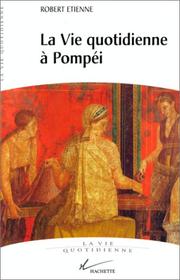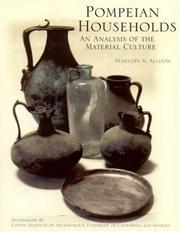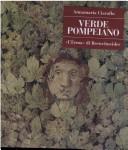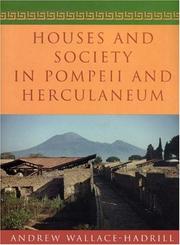| Listing 1 - 5 of 5 |
Sort by
|

ISBN: 2012354408 9782012354401 Year: 1998 Publisher: Paris Hachette
Abstract | Keywords | Export | Availability | Bookmark
 Loading...
Loading...Choose an application
- Reference Manager
- EndNote
- RefWorks (Direct export to RefWorks)

ISBN: 0917956966 9780917956966 Year: 2004 Publisher: Los Angeles (Calif.) : Cotsen Institute of Archaeology,
Abstract | Keywords | Export | Availability | Bookmark
 Loading...
Loading...Choose an application
- Reference Manager
- EndNote
- RefWorks (Direct export to RefWorks)
Material culture --- Furniture, Ancient --- Architecture, Domestic --- Culture matérielle --- Meubles anciens --- Architecture domestique --- Pompeii (Extinct city) --- Pompéi (Ville ancienne) --- Social life and customs. --- Moeurs et coutumes --- Culture matérielle --- Pompéi (Ville ancienne) --- Material culture - Italy - Pompeii (Extinct city) --- Furniture, Ancient - Italy - Pompeii (Extinct city) --- Architecture, Domestic - Italy - Pompeii (Extinct city) --- Pompeii (Extinct city) - Social life and customs

ISBN: 8882650561 9788882650568 Year: 1999 Publisher: Roma "L'Erma" di Bretschneider
Abstract | Keywords | Export | Availability | Bookmark
 Loading...
Loading...Choose an application
- Reference Manager
- EndNote
- RefWorks (Direct export to RefWorks)
Botany in art --- Gardens in art --- Gardens in literature --- Botany in literature --- Botany --- Plant remains (Archaeology) --- Gardens, Roman --- Pompeii (Extinct city) --- Economic conditions --- Social life and customs --- Botany - Italy - Pompeii (Extinct city) --- Plant remains (Archaeology) - Italy - Pompeii (Extinct city) --- Gardens, Roman - Italy - Pompeii (Extinct city) --- Pompeii (Extinct city) - Economic conditions --- Pompeii (Extinct city) - Social life and customs
Book
ISBN: 0674416538 067441652X 9780674416529 9780674047938 0674047931 Year: 2014 Publisher: Cambridge, Massachusetts ; London, England : Harvard University Press,
Abstract | Keywords | Export | Availability | Bookmark
 Loading...
Loading...Choose an application
- Reference Manager
- EndNote
- RefWorks (Direct export to RefWorks)
When Vesuvius erupted in 79 CE, the force of the explosion blew the top right off the mountain, burying nearby Pompeii in a shower of volcanic ash. Ironically, the calamity that proved so lethal for Pompeii's inhabitants preserved the city for centuries, leaving behind a snapshot of Roman daily life that has captured the imagination of generations. The experience of Pompeii always reflects a particular time and sensibility, says Ingrid Rowland. From Pompeii: The Afterlife of a Roman Town explores the fascinating variety of these different experiences, as described by the artists, writers, actors, and others who have toured the excavated site. The city's houses, temples, gardens--and traces of Vesuvius's human victims--have elicited responses ranging from awe to embarrassment, with shifting cultural tastes playing an important role. The erotic frescoes that appalled eighteenth-century viewers inspired Renoir to change the way he painted. For Freud, visiting Pompeii was as therapeutic as a session of psychoanalysis. Crown Prince Hirohito, arriving in the Bay of Naples by battleship, found Pompeii interesting, but Vesuvius, to his eyes, was just an ugly version of Mount Fuji. Rowland treats readers to the distinctive, often quirky responses of visitors ranging from Wolfgang Amadeus Mozart, Charles Dickens, and Mark Twain to Roberto Rossellini and Ingrid Bergman. Interwoven throughout a narrative lush with detail and insight is the thread of Rowland's own impressions of Pompeii, where she has returned many times since first visiting in 1962.
Tourism --- Holiday industry --- Operators, Tour (Industry) --- Tour operators (Industry) --- Tourism industry --- Tourism operators (Industry) --- Tourist industry --- Tourist trade --- Tourist traffic --- Travel industry --- Visitor industry --- Service industries --- National tourism organizations --- Travel --- History. --- Economic aspects --- Pompeii (Extinct city) --- Pompei (Extinct city) --- Pompeii (Ancient city) --- Italy --- Civilization. --- Social life and customs. --- Antiquities --- Tourism-Italy-Naples (Province)-History. --- Pompeii (Extinct city)-History. --- Pompeii (Extinct city)-Civilization. --- Pompeii (Extinct city)-Social life and customs.

ISBN: 0691069875 9780691029092 0691029091 9780691069876 Year: 1994 Publisher: Princeton (N.J.) : Princeton university press,
Abstract | Keywords | Export | Availability | Bookmark
 Loading...
Loading...Choose an application
- Reference Manager
- EndNote
- RefWorks (Direct export to RefWorks)
Few sources reveal the life of the ancient Romans as vividly as do the houses preserved by the eruption of Vesuvius. Wealthy Romans lavished resources on shaping their surroundings to impress their crowds of visitors. The fashions they set were taken up and imitated by ordinary citizens. In this illustrated book, Andrew Wallace-Hadrill explores the rich potential of the houses of Pompeii and Herculaneum to offer new insights into Roman social life. Exposing misconceptions derived from contemporary culture, he shows the close interconnection of spheres we take as discrete: public and private, family and outsiders, work and leisure. Combining archaeological evidence with Roman texts and comparative material from other cultures, Wallace-Hadrill raises a range of new questions. How did the organization of space and the use of decoration help to structure social encounters between owner and visitor, man and woman, master and slave? What sort of "households" did the inhabitants of the Roman house form? How did the world of work relate to that of entertainment and leisure? How widely did the luxuries of the rich spread among the houses of craftsmen and shopkeepers? Through analysis of the remains of over two hundred houses, Wallace-Hadrill reveals the remarkably dynamic social environment of early imperial Italy, and the vital part that houses came to play in defining what it meant to live as a Roman.
Material culture --- Architecture, Domestic --- Culture matérielle --- Architecture domestique --- Herculanum (Ville ancienne) --- Pompeii (Extinct city) --- Herculaneum (Extinct city) --- Pompéi (Ville ancienne) --- Social life and customs. --- Social life and customs --- Buildings, structures, etc. --- Moeurs et coutumes --- Constructions --- Buildings, structures, etc --- -Architecture, Domestic --- -Material culture --- -Culture --- Folklore --- Technology --- Architecture, Rural --- Domestic architecture --- Home design --- Houses --- One-family houses --- Residences --- Rural architecture --- Villas --- Architecture --- Dwellings --- -Herculaneum (Extinct city) --- -Pompeii (Extinct city) --- -Pompei (Extinct city) --- Pompeii (Ancient city) --- Italy --- Ercolano (Extinct city) --- Herculaneum (Ancient city) --- Antiquities --- -Buildings, structures, etc --- Culture matérielle --- Pompéi (Ville ancienne) --- Culture --- Pompei (Extinct city) --- Centre [Région] (Belgique) --- Coal mines and mining --- History --- Architecture [Domestic ] --- Pompeii (Extinct city) - Social life and customs. --- Herculaneum (Extinct city) - Social life and customs. --- Pompeii (Extinct city) - Buildings, structures, etc. --- Herculaneum (Extinct city) - Buildings, structures, etc. --- Material culture - Italy - Pompeii (Extinct city) --- Material culture - Italy - Herculaneum (Extinct city) --- Architecture, Domestic - Italy - Pompeii (Extinct city) --- Architecture, Domestic - Italy - Herculaneum (Extinct city) --- Pompeii (Extinct city) - Social life and customs --- Herculaneum (Extinct city) - Social life and customs --- Herculaneum (Extinct city) - Buildings, structures, etc
| Listing 1 - 5 of 5 |
Sort by
|

 Search
Search Feedback
Feedback About
About Help
Help News
News